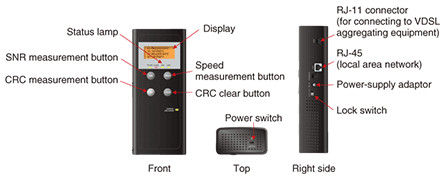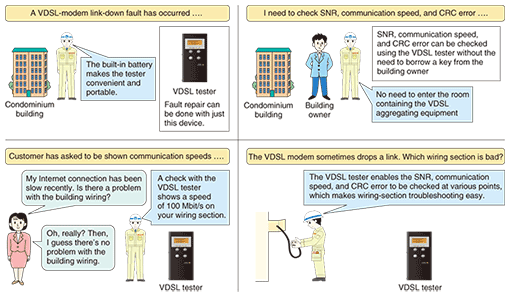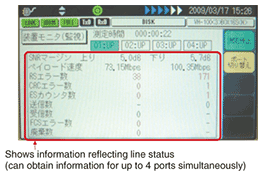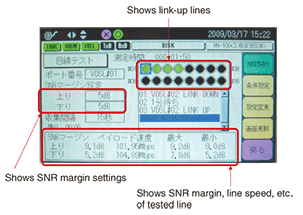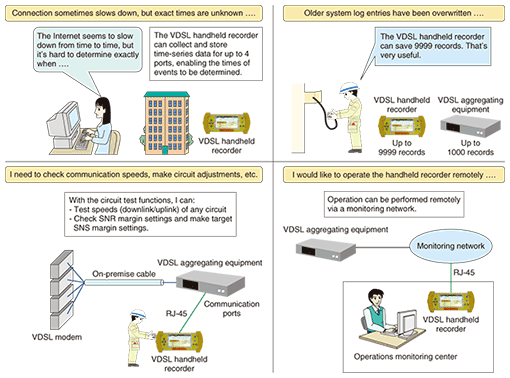 |
|||
|
|
|||
|
Special Feature on Technical Solutions to Real-world Problems Vol. 8, No. 9, pp. 12–15, Sept. 2010. https://doi.org/10.53829/ntr201009sf3 VDSL Fault Troubleshooting ToolsAbstractThe Technical Assistance and Support Center at NTT EAST has developed a very-high-speed digital subscriber line (VDSL) tester and VDSL handheld recorder on the basis of feedback received from its fault-repair department. These devices are used as tools for troubleshooting faults in the VDSL wiring section inside buildings as part of the B FLET’S broadband-connection service.
1. VDSL tester1.1 Development backgroundIn Japan, NTT offers its B FLET’S broadband-connection service by very-high-speed digital subscriber line (VDSL) access to multi-dwelling units like condominium buildings. However, in such buildings, poor wiring can account for most of the faults that arise in service provision. Troubleshooting during fault-repair work has required maintenance personnel to move about a building while carrying a VDSL modem, and the difficulty of securing a power supply and other problems have hampered the troubleshooting process. The current circumstances of VDSL fault repair can be summarized as follows.
1.2 FunctionsThe new VDSL tester is battery-powered, so it does not require a mains power supply during troubleshooting. It also has a VDSL-link measurement function that enables a link status to be checked quantitatively. External views of the VDSL tester are shown in Fig. 1. VDSL tester functions are listed below.
1.3 Usage scenariosThe VDSL tester’s built-in battery makes it easier for maintenance personnel to troubleshoot while moving about a building and its measurement functions let maintenance personnel check the state of building wiring in practical terms. The VDSL tester can be used in various ways, as shown in Fig. 2.
2. VDSL handheld recorder2.1 Development backgroundFaults in the B FLET’S service via VDSL do not necessarily occur on a regular basis. Instead, they tend to be unpredictable or mysterious; for example, links occasionally just go down. For faults like these, an analysis of the VDSL aggregating equipment’s system log can identify details of a dropped link such as the line and fault occurrence time. However, the system log can store a maximum of only 1000 records, which means that log data at the time of a customer’s fault report will eventually be overwritten and lost. Furthermore, even if the dropped link’s line and time can be recovered from the system log, the cause of the event cannot be inferred from this information. 2.2 Functions(1) System log monitoring While the system log of the VDSL aggregating equipment can hold only up to 1000 records, the VDSL handheld recorder can store up to 9999 records, so its log is about ten times the size of the conventional system log. (2) Line-status monitor The VDSL aggregating equipment stores information reflecting line status. For example, it stores CRC error and noise-margin values that affect noise resistance. Obtaining such information periodically and monitoring changes in line status over time can aid in determining the cause of the fault. A screenshot of the line-status monitor is shown in Fig. 3.
(3) Crosstalk test The effects of crosstalk in a cable within the customer’s building can be checked by manipulating the link status (up or down) of certain lines and measuring how the line status elsewhere changes as a result. A screenshot of the crosstalk test is shown in Fig. 4.
2.3 Usage scenariosObtaining system-log data and line-related information in a time-series manner enables maintenance personnel to investigate phenomena leading up to a fault and to infer whether the fault is being caused by crosstalk, noise, or some other problem. Besides being used while directly connected to VDSL aggregating equipment, the VDSL handheld recorder can be used remotely via a monitoring network. Usage scenarios for the VDSL handheld recorder are shown in Fig. 5.
3. Concluding remarksThe VDSL tester was released in April 2009 and by October 2009 about 800 units were in use by the maintenance and service-order departments of NTT EAST, NTT WEST, and affiliated companies. The VDSL handheld recorder is scheduled to be released in fiscal-year 2010 following a trial period. |
|||








